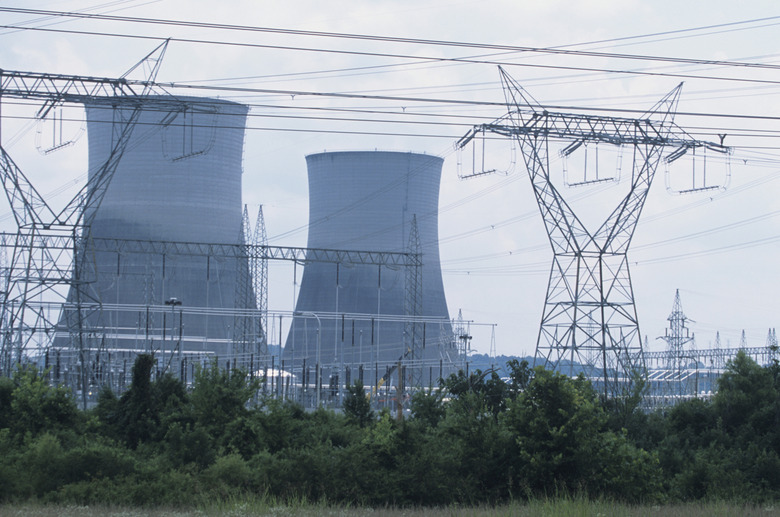How Does Nuclear Energy Get From The Plant To The Customer?
Nuclear power plants have many features in common with traditional electrical power facilities; the main difference is that they produce energy with radioactive materials instead of conventional fuels. The same commercial power grid carries electricity from nuclear and fossil-fuel plants as well as renewable sources. A series of power distribution lines carries the electricity from the sources to the end users, including homes, commercial customers, government and industry.
Nuclear Reaction and Heat
Nuclear Reaction and Heat
A nuclear reactor produces large amounts of heat from the controlled radioactive decay of elements such as uranium and plutonium. The nuclei of these heavy elements are unstable; they emit radiation in the form of neutrons, alpha and beta particles and gamma rays, becoming more stable in the process. As they produce radiation, they also become very hot. In a nuclear reactor, the heat is used as a substitute for the burning of coal or natural gas. Both fossil fuel and nuclear power plants use heat to boil water and make steam.
Steam and Generator
Steam and Generator
Pipes carry high-pressure steam from the nuclear reactor to a steam-powered turbine. The steam propels the turbine's blades, causing the turbine shaft to spin rapidly, turning a generator that produces electricity. The steam condenses into water, which is recycled back to the reactor to become steam again. A typical nuclear power plant has several turbines and generators working in tandem.
Step-Up Transformer and High-Voltage Lines
Step-Up Transformer and High-Voltage Lines
A device called a transformer uses principles of electromagnetic induction to connect two alternating-current (AC) circuits together. In addition, a transformer can increase or decrease the voltage of the AC at its input; utilities use high-voltage lines to carry electricity long distances efficiently, so they employ step-up transformers near the power plant to increase a generator's output. The transformer's output voltage is set to match the capacity of local high-tension power lines, which may range from 230,000 to 765,000 volts.
Step-Down Transformers and Distribution
Step-Down Transformers and Distribution
Power companies transmit electricity at high voltage to reduce energy losses, but the high voltage is not useful or safe for most customers. The high-voltage lines are connected to substations having step-down transformers that reduce the voltage for commercial and industrial users. Once the power lines reach the level of neighborhoods, the voltages are reduced further for home use. In the U.S., utilities provide 120-, 208- and 240-volt service for homes and small businesses.
Cite This Article
MLA
Papiewski, John. "How Does Nuclear Energy Get From The Plant To The Customer?" sciencing.com, https://www.sciencing.com/nuclear-energy-plant-customer-16361/. 24 April 2017.
APA
Papiewski, John. (2017, April 24). How Does Nuclear Energy Get From The Plant To The Customer?. sciencing.com. Retrieved from https://www.sciencing.com/nuclear-energy-plant-customer-16361/
Chicago
Papiewski, John. How Does Nuclear Energy Get From The Plant To The Customer? last modified March 24, 2022. https://www.sciencing.com/nuclear-energy-plant-customer-16361/
